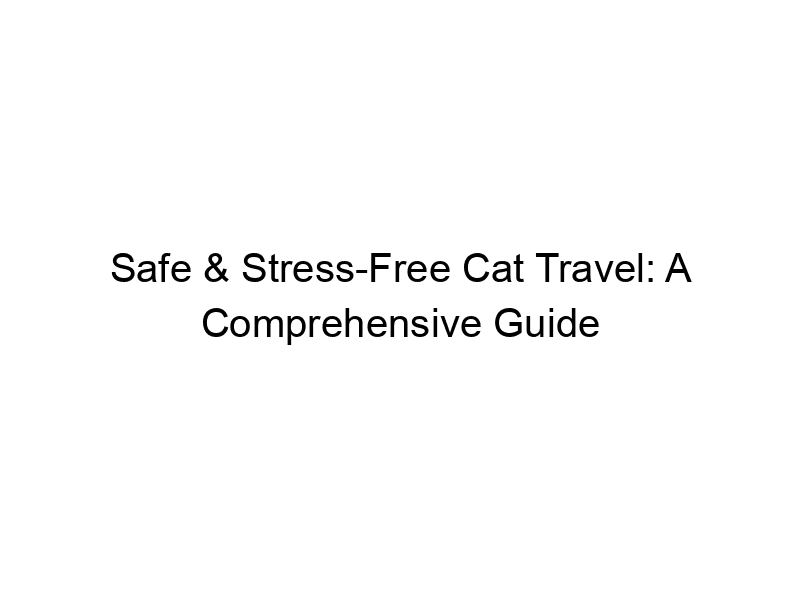Preparing for a journey with your feline companion can be daunting. This guide will equip you with the knowledge and strategies to ensure a safe and stress-free experience for both you and your cat. How to Safely Travel with Your Cat: Tips for Stress-Free Trips covers everything from pre-trip preparation to post-travel care, making your next adventure with your furry friend a truly enjoyable one. You’ll learn about essential travel documents, carrier selection, minimizing stress, and even how to handle potential emergencies. Let’s embark on this journey together!
Before you even consider booking tickets, ensure your cat is healthy enough for travel. Schedule a veterinary checkup to receive a health certificate, essential for many airlines and border crossings. Discuss any potential health concerns and receive recommendations for
travel medications, if necessary. Consider your cat’s personality; anxious cats may require extra preparation and possibly medication to manage stress.
Choosing the Right Travel Method: Car, Plane, or Train?
The best travel method depends on distance and your cat’s temperament. Car trips offer greater control over the environment but can be longer and more tiring. Air travel is faster for long distances but can be stressful for cats. Trains are a middle ground, offering a more spacious and less stressful environment than planes. Each method requires specific preparations discussed later.
Essential Travel Documents and Preparations
Gathering Necessary Documents: Health Certificates and Identification
Your veterinarian will provide a health certificate verifying your cat’s health status and vaccinations. This is often a requirement for airline travel and crossing international borders. Ensure your cat has proper identification, such as a microchip and collar with ID tags, with updated contact information.
Booking Your Travel: Airlines, Trains, and Pet-Friendly Accommodations
Research airlines with pet-friendly policies, understanding their size and crate restrictions. Book flights well in advance, as space for pets is often limited. Similarly, if choosing train travel, confirm pet policies and reserve a pet-friendly compartment. For your destination, reserve pet-friendly accommodation in advance.
Choosing the Right Carrier for Your Cat
Selecting a Safe and Comfortable Carrier: Size, Ventilation, and Features
Invest in a sturdy, well-ventilated carrier large enough for your cat to stand, turn around, and lie down comfortably. Look for features like secure latches, escape-proof design, and ideally, a removable top for easier access. Avoid carriers with inadequate ventilation, which can lead to overheating.
Acclimating Your Cat to the Carrier Before Travel
Introduce your cat to the carrier gradually before the trip. Leave it open in a familiar area with toys and treats, allowing your cat to explore and associate it with positive experiences. Feed your cat meals inside the carrier to further reinforce positive associations.
Minimizing Travel Stress for Your Cat
Understanding Feline Stress: Symptoms and Management
Cats exhibit stress in various ways: excessive grooming, hiding, vocalization, changes in appetite, and litter box issues. Understanding these signs helps you address them promptly. Employ stress-reducing techniques like pheromone diffusers (Feliway) or calming supplements, consulting your veterinarian for guidance.
Creating a Calming Travel Environment: Temperature, Noise, and Security
Maintain a comfortable temperature in your cat’s carrier and avoid sudden temperature changes. Limit noise and vibration as much as possible. Provide a soft, familiar blanket or toy to create a sense of security. Consider a travel harness and leash for brief periods outside the carrier, ensuring your cat’s safety.
Food and Water During Travel
Packing Adequate Food and Water Supplies: Bowls and Containers
Pack enough food and water for the entire journey, plus a little extra. Use leak-proof containers and bowls to prevent spills and messes. Consider a travel-friendly water fountain to encourage hydration.
Feeding and Watering Your Cat: Frequency and Strategies
Feed your cat small meals before, during, and after travel, depending on the duration. Offer fresh water frequently. Adjust feeding times according to your cat’s schedule. If traveling by car, take regular breaks to allow your cat to use the litter box and stretch its legs.
Safety Precautions During Travel
Securing Your Cat in the Carrier: During Car, Plane, and Train Journeys
Always secure your cat’s carrier appropriately during travel. In a car, use a seatbelt or secure it in the backseat. On a plane, follow airline instructions for securing the carrier. On a train, ensure the carrier is placed in a stable and safe location.
Handling Unexpected Situations: Emergencies and Delays
Prepare for unforeseen circumstances. Have an emergency kit with essential supplies, including medications, food, water, and a first-aid kit specifically for cats. Know the location of veterinary services near your destination. Have contingency plans for delays or cancellations.
Post-Travel Care for Your Cat
Monitoring Your Cat for Stress or Illness: Signs and Symptoms
After arriving at your destination, monitor your cat closely for signs of stress or illness. If you notice changes in behavior, appetite, or litter box habits, consult your veterinarian immediately.
Helping Your Cat Adjust to a New Environment: Gradual Introduction
Allow your cat to adjust to the new environment gradually. Keep them in a quiet, secure space initially and gradually expand their access to the rest of the house. Provide familiar toys and bedding.
Using Technology to Enhance Safety During Travel
Tracking Devices and GPS Locators: Pet GPS Tracking
Consider using a GPS tracker for your cat, especially if they are prone to escaping. These devices help locate your cat if they get lost. Choose a tracker with a reliable GPS signal and long battery life.
Protecting Your Data with a VPN: Privacy and Security During Travel
A VPN (Virtual Private Network) encrypts your internet traffic, protecting your data from unauthorized access, especially on public Wi-Fi networks. Services like ProtonVPN, Windscribe, and TunnelBear offer various levels of security and privacy. A VPN is like creating a secure, encrypted tunnel for your data, making it much harder for others to intercept it.
Choosing the Right Cat Carrier Accessories
Harness and Leash for Safe Outdoor Excursions
A properly fitted harness and leash allows supervised outdoor walks for your cat. This requires gradual acclimation; never force your cat to wear a harness.
Travel Bowls and Water Fountains for Convenient Feeding
Consider collapsible travel bowls and water fountains for easier transport and cleaning. Choose materials that are easy to clean and durable.
Frequently Asked Questions
What are the best airlines for traveling with cats?
Many airlines allow pets, but policies vary. Research airlines known for their pet-friendly policies, and always confirm their current regulations before booking. Consider factors like crate size limits and in-cabin vs. cargo options.
How can I prevent my cat from getting carsick during travel?
Feed your cat a light meal several hours before travel. Avoid strong-smelling foods. Short, frequent breaks can help them relieve themselves and stretch. Ask your vet about anti-nausea medication if needed.
What should I pack in my cat’s emergency kit for travel?
Include a copy of your cat’s vaccination records, a current photo, food and water for at least 24 hours, a litter box and litter, a first-aid kit (with cat-specific supplies), any necessary medications, a blanket or towel, and a small toy.
How do I choose a good VPN for online security during travel?
Look for a reputable VPN provider with strong encryption (AES-256 is ideal), a no-logs policy, and a wide server network. ProtonVPN, Windscribe, and TunnelBear are popular choices, each offering varying features and price points. Consider whether you need a free or paid VPN. Windscribe offers 10GB free data monthly, which might suffice for shorter trips, while ProtonVPN and TunnelBear offer free options with limited functionality.
Can I sedate my cat for air travel?
Consult your veterinarian about the use of sedatives for air travel. They can advise on appropriate medications and dosages. Note that some airlines prohibit sedated animals.
What are the signs of cat stress during travel?
Signs of stress include excessive meowing, hiding, restlessness, changes in appetite, and urination or defecation outside the litter box. Observe your cat closely and take steps to alleviate stress as soon as possible.
Final Thoughts
Traveling with your cat can be a rewarding experience, filled with shared adventures and cherished memories. By carefully planning, prioritizing your cat’s well-being, and using the tips and resources outlined in this guide, you can ensure a safe, comfortable, and stress-free journey for both of you. Remember to prioritize your cat’s comfort and safety throughout the process. From choosing the right carrier and minimizing stress to packing essential supplies and being prepared for emergencies, every step contributes to a smoother travel experience. Don’t forget to check the specific regulations of your chosen airline or transportation method. Start planning today, and embark on your next adventure with your beloved feline companion with confidence! Consider using a VPN like Windscribe to enhance your online security during your travels. It’s a simple step that can provide significant peace of mind.




